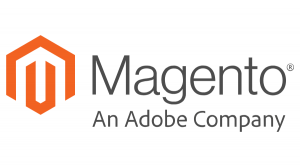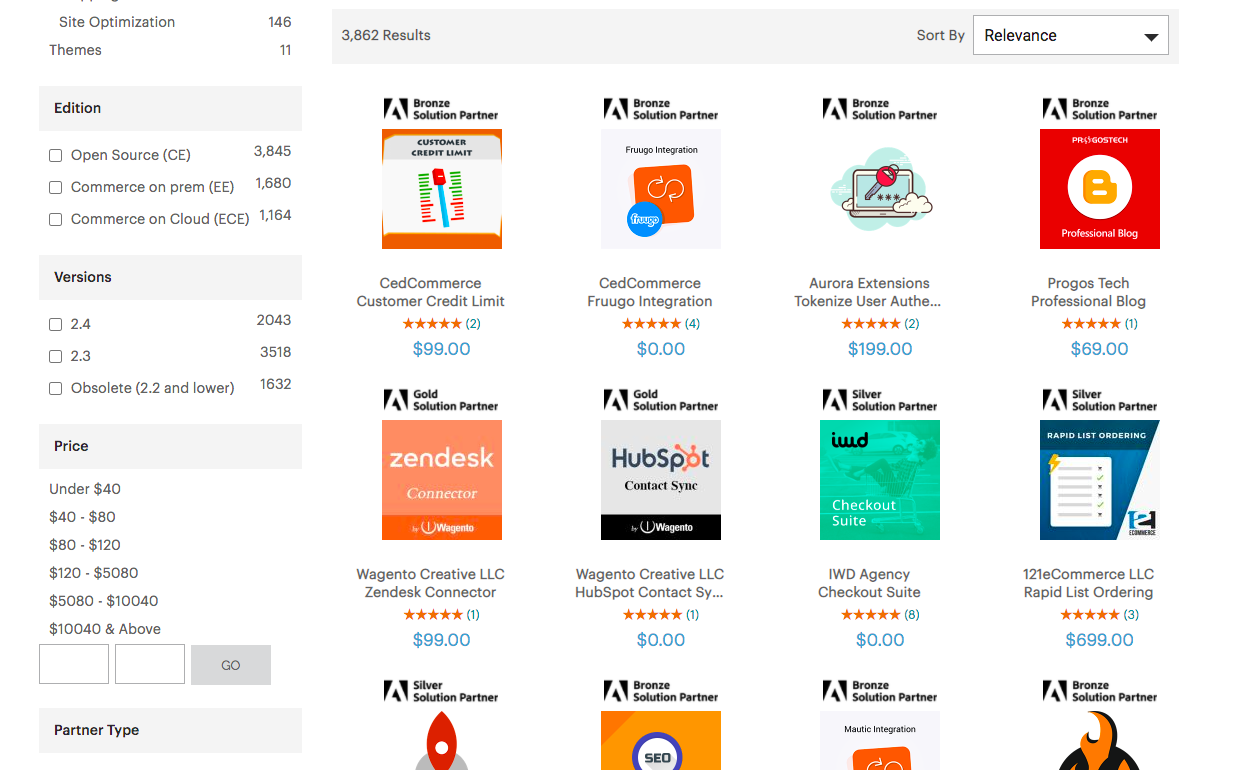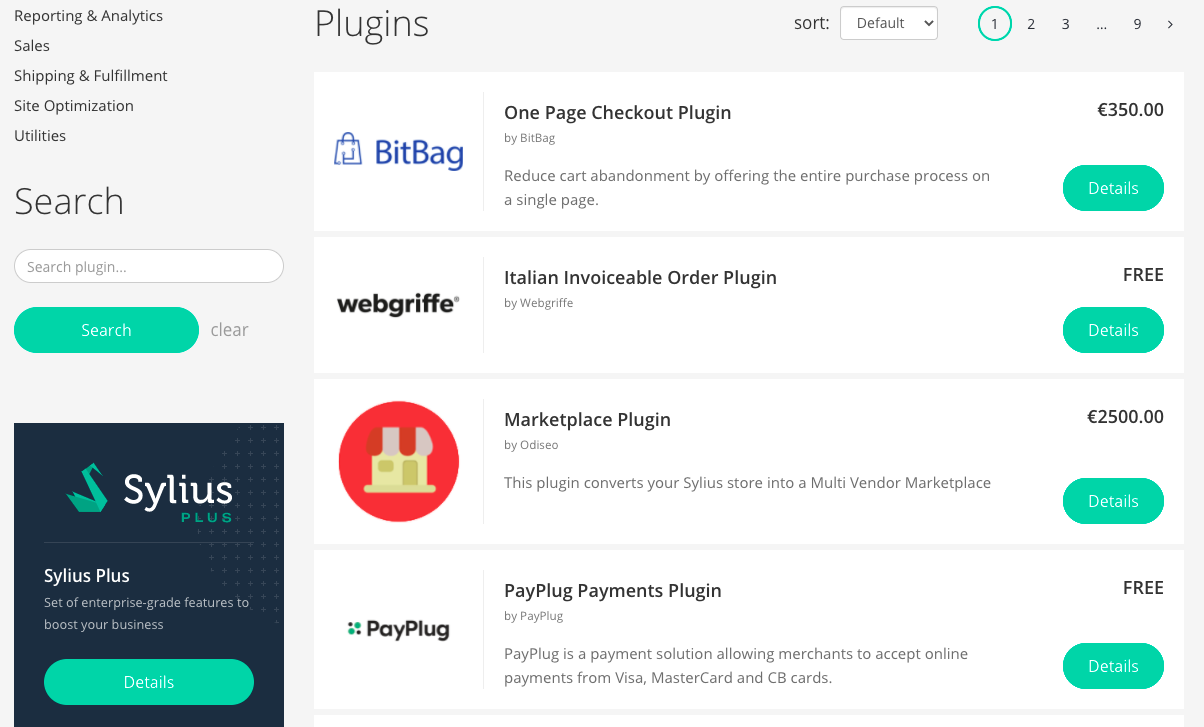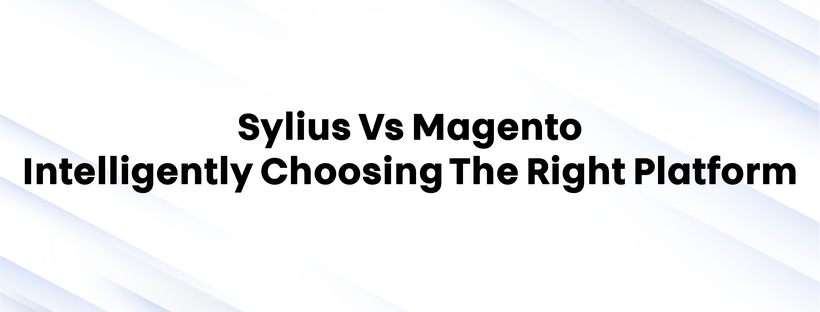Ecommerce is becoming an indispensable component in our lives. The busier people get, the more important eCommerce is. When people tend not to have much time to visit brick-and-mortar stores, eCommerce is the perfect option.
Hence, an increasing number of businesses have expanded and developed their online stores. If you are only running a physical shop, you are so outdated and your shop cannot compete with others. So the advice is to establish an online store right now.
And without a doubt, the most important, most challenging, and the first step is probably choosing the right platform.
To help you with this first step, we want to compare different platforms, mainly Magento versus others. Today’s topic is the Sylius vs Magento competition. Let’s find out what their strengths and weaknesses are!
Check more competitions of:
- osCommerce vs Magento
- Magento vs Demandware (Salesforce Commerce Cloud)
- Magento vs Laravel
- Odoo vs Magento
Sylius Vs Magento – Who Are They?
About Magento

Magento might be familiar with eCommerce businesses. It is considered one of the most popular platforms recently. Magento is an open-source platform written in PHP, published in 2008, then acquired by Adobe Inc. 10 years later.
Since it was first developed, Magento has powered around 740.000 websites; of which there are more than 200.000 live websites at present. This figure is still at the top in terms of the number of eCommerce platform users.
Many businesses have chosen the platform because of its out-of-the-box features. Moreover, with professional developer teams, a large community, a considerable number of partners worldwide, it is understandable that Magento is well-known in the market.
At present, Magento offers 2 editions with 3 pricing plans:
- Magento Community Edition (CE): FREE
- Magento Enterprise Edition (EE)
- Magento Commerce Cloud
About Sylius

Sylius is a Symfony-based open-source headless eCommerce platform. It is relatively suited for all types of business. This solution is also part of the BDD (Behavior-Driven Development: Behavioral Development) through Behat – a reliable PHP framework that makes it easy to automate reading your wishes.
Recently, Sylius has just released the new version, Sylius v1.9. It is the first eCommerce platform to fully support Symfony 5, the latest, fastest and most powerful PHP framework today. Since the last release of Sylius 1.8, Sylius v1.9 has been updated to reach several sprint goals.
While Magento, Shopify, WooCommerce, and some others are leading the eCommerce game, Sylius is still an uncommon name with only 1.616 live websites, according to BuiltWith.
However, Sylius comes into play as a framework, making it easier for developers to create more organized eCommerce solutions. Therefore, it is a potential name to take the lead in the future.
Sylius Vs Magento – What Are The Differences?
Features
Magento’s features are so typical for businesses of all types, both B2B and B2C. It contains a large number of optimal features that help to build a perfect website. Not to mention a vast marketplace of plugins and integrations, Magento itself has all essential functionalities.
Magento’s feature list:
- Page builder & content staging
- Customer segmentation and personalization
- Dynamic rule-based product relations
- Instant purchase
- Visual merchandising
- Powerful business intelligence capabilities
- Responsive design templates
- Progressive Web Application (PWA) studio
- Integrated B2B functionality
- Inventory management
- Powerful admin experience
- Technical and account support
- Cloud infrastructure
Notably, Magento has B2B functionalities at default. This is convenient for those businesses that want to target different customers on a single interface.
Sylius is an API-first solution. Sylius’s team decided to create Sylius APIs with an API platform, a system for developing modern API-driven projects beloved by all Symfony developers to stay on top of the backend eCommerce technology race.
Sylius’s feature list:
- Cross-border commerce
- Multi-currencies, departments, countries
- Multi-everything commerce
- Flexible checkout and order management flow
- Flexible promotions and discounts
- Modern and scalable infrastructure
- Adaptable administration panel
- Advanced multi-store
- Advanced user-permissions
- Returns management
- Multi-source inventory
- Partial order fulfillment
- Admins per channel
- Loyalty system
Performance (Loading Speed)

Website loading speed is the key factor to retain customers. A survey by Kissmetrics has shown that nearly 50% of customers expect one website to load within 2 seconds. Moreover, about 40% of visitors want to abandon the website if it takes more than 3 seconds to load.
For that reason, if you don’t want to lose any of your potential customers, enhancing the loading speed is essential.
For a long time, Magento has been highly appreciated in terms of site performance. Magento continuously updates and corrects its performance to improve the page loading speed and minimize losses caused by slow speed.
Magento 2 is more updated than Magento 1, with a lot more optimal features, which means that it has a more demanding engine. Recently, some Magento users have complained about their site performance. But it is not something you cannot fix. Magento and the community have suggested some solutions:
- Updating to the latest version
- Enabling the Flat catalog
- Enabling the log cleaning in the admin panel
- Merging Javascript and CSS Files
- Reindexing data (price, carts, amount, discounts, etc.)
- Enabling caching
- Choosing a better web hosting
- Optimizing images
Sylius is a little better than Magento in terms of performance. It is a Symfony-based framework, an exceptional PHP framework. When it comes to web performance, Sylius users don’t need to do many actions to configure. This makes Sylius page load much faster compared to Magento, the page load without caching mechanisms in dev mode.
Although Sylius is relatively faster than Magento 2, you still need to enhance its performance as much as possible to get the best results. To do that, there are some suggestions:
- Prioritizing assets loading: At the beginning, loading only necessary assets.
- Using ElasticSearch for product search
- Keeping frequently used data in the cache
- Reducing the assets’ weight
- Using Varnish to cache static pages
Hosting

Both Sylius and Magento are self-hosted platforms. This means that users can customize the platform based on their demands without depending on the provider.
This will create pros and cons for businesses. Although users can freely customize, they have to take full responsibility for the result, with no guarantee from the provider of, for example, security. So if businesses do not have enough skill to configure the store, it will be a big disadvantage.
SEO

Magento is relatively famous for its SEO features at default. Using Magento means that you are building an SEO-friendly website. According to Ecommerce Platform, Magento’s SEO score is quite high, 95/100. This has proved the increased SEO capabilities of Magento.
Magento contains various optimal SEO features to help your website rank higher on search engines; hence, you can drive more traffic to your page. Magento SEO settings enable users to set URL key, metadata, meta titles, keywords, meta tags for products, reports and analytics to follow customer behaviors.
Sylius also supports SEO management. However, it is not highlighted in the feature list. If you need to optimize SEO on your Sylius website, downloading plugins is necessary.
Therefore, we can say that Magento is a winner in terms of SEO performance.
Customizability

Both platforms make it easy for users to customize their demands. However, we guess that Sylius is a little more customizable than Magento.
Magento contains many default features that users can easily customize in their store, some of which might not appear in other eCommerce systems. Although several features cannot be accessed for free, you can get them by using paid versions. But still, users consider Magento is more complicated and time-consuming due to the code complexity.
For Sylius, users can effortlessly customize anything because of the organized development. Also, Sylius has set a standard for coding that users can follow with minimal effort.
Time to Market
It requires a long time to marketing using Magento. Typically, it takes about 3 to 9 months for a Magento website to be ready to run.
On the other hand, Sylius is easily customizable; hence, its time to market is usually a few times faster than Magento. A comparable B2C architecture could be built on top of Sylius three times faster than Magento 2.
Marketplace

We supposed that no platform could beat Magento’s marketplace. Magento has the world’s biggest extension marketplace with nearly 4.000 plugins and integrations developed by its partners. Not only that, there are thousands of other add-ons by the best Magento service providers in various price ranges, including free of charge.
Those extensions are the best options for users to perfectly complete their online stores. Besides default features, which are probably not enough for a website, purchasing some extensions is needed.

Sylius also owns a marketplace; however, it is smaller compared to Magento’s. There are more than 250 plugins developed by Sylius partners, both free and paid. Such extensions support the website in a wide range of categories, including accounting & finance, content, marketing, etc.
Community Support

The Magento community is extremely well-known among developers and businesses. Magento has over 300.000 developers worldwide. For that reason, you can find professionals to help to build your eCommerce site with little effort wherever your business is located.
Furthermore, its vast global network with approximately 1.300 solution and technology partners makes it a world-leading platform for service and support. Also, there are many forums that enable businesses to discuss with experienced developers.
In contrast, Sylius is not such a common name in the market; consequently, its community support is limited in comparison with Magento’s. It is pretty tricky for Sylius users to seek support in some countries. However, Sylius is developed based on Symfony, which is more convenient for users to get help from Symfony developers.
Like Magento, Sylius offers support through well-written documentation, which is relatively easy to understand as well as tutorial Youtube videos and forums with many blog posts.
Pricing
Pricing plan is another crucial factor that helps enterprises make a decision. Small to medium enterprises with limited budgets prefer to choose an affordable pricing plan with essential features. But it is not the same with large enterprises.
Magento offers users 2 editions with 3 pricing plans, one free of charge (Magento Community Edition), quite suitable for small to medium enterprises (SMEs). The other 2 require users to make a one-time payment and are calculated based on the gross sales revenue of the business.
| Gross Sales Revenue | Magento Commerce (Enterprise Edition) | Magento Commerce Cloud |
|---|---|---|
| Less than $1 million | $22.000 | $40.000 |
| $1 million - $5 million | $32.000 | $55.000 |
| $5 million - $10 million | $49.000 | $80.000 |
| $10 million - $25 million | $75.000 | $120.000 |
| $25 million - $50 million | $125.000 | $190.000 |
Similar to Magento, Sylius also offers a free edition. However, it only contains standard features to run a website, which is not enough to optimize the site. Hence, if you want to own advanced features such as advanced multi-store, advanced user permissions, SLA-backed technical support, it is necessary to buy Sylius Plus.
The Sylius Plus pricing is calculated based on the Gross Merchandise Volume (GMV) model, usually from 1-2% of GMV. Ask for a quote now to get precise pricing.
Sylius Vs Magento – Who Is The Winner?

It is hard to decide who is the winner as it depends much on your business demands of business types, technology, inventory size, budget, etc.
However, we still recommend using Magento for several reasons:
- It suits any type of business, from small to large enterprises, both B2B and B2C businesses.
- It contains various optimal features, including B2B functionalities.
- Magento is an SEO-friendly platform.
- It has a massive marketplace with thousands of excellent extensions that provide optimal additional features.
- There is a large community with many partners and developers worldwide.
To help you quickly make a decision, we will summarize our post in the table below.
| Magento | Sylius | |
|---|---|---|
| Business type | Small to large enterprises in any type | Mid-market & enterprises |
| Features | ||
| Performance (Loading speed) | Slower due to the platform complexity | Faster |
| Hosting | Self-hosted | Self-hosted |
| SEO | SEO optimization features | Limited features |
| Customizability | More customizable | |
| Time to market | 3-9 months | Faster time to market |
| Marketplace | Massive (over 3.800 extensions) | Small (over 250 extensions) |
| Community Support | Large community (1.300 partners, 300.000 developers) | Small community |
| Pricing | Starting from $22.000 | Calculated based on GMV model |
Conclusion

We have compared the 2 platforms, Sylius vs Magento, in detail. We hope that this blog post will help you easily choose the right platform for your business.
If you want us to deliver other comparisons of other platforms, please comment in the section below. We will give a response as soon as possible.
Thanks a lot for reading.

